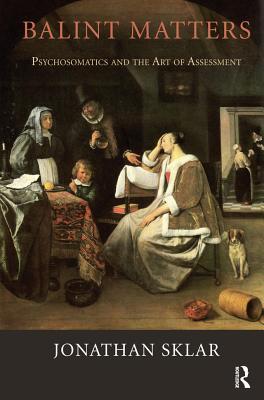Read Online Balint Matters: Psychosomatics and the Art of Assessment - Jonathan Sklar file in PDF
Related searches:
Review of Balint Matters: Psychosomatics and the Art of Assessment
Specialties Balint Matters Psychosomatics and the Art of
Proving nothing and illustrating much: The case of Michael Balint
Balint Matters Psychosomatics and the Art of Assessment
Jonathan Sklar, Balint Matters: Psychosomatics and the Art of
Balint matters: psychosomatics and the art of assessment
New book: BALINT MATTERS Psychosomatics and the Art of
Balint Matters: Psychosomatics and the Art of Assessment , by
Balint matters: psychosomatics and the art of assessment: by
freud quotes: Balint Matters: Psychosomatics and the Art of
News The Balint Society
The Basic Fault: Therapeutic Aspects of Regression Contents
Psychosomatic Medicine And Contemporary Psychoanalysis - UNEP
The legacy of Michael Balint - PubMed
History, aims and present structure of psychosomatic medicine in
The Psychosomatic Assessment
Psychosomatic Medicine and Balintwork - International Balint
Hemianopia and Features of Bálint Syndrome following Occipital
Psychosomatic disorder - Diagnosis and Treatment
4422 4217 3102 2887 3470 300 4211 3006 2991
The leaders of traditional balint groups guide group members toward open dis cussion of case material by of a case by shifting attention to other matters. The role of the cluded death and dying, family problems, psychosomatic issu.
The leader is that physicians who regularly attend balint groups found psychosomatic patients.
Balint matters: psychosomatics and the art of assessment - kindle edition by sklar, jonathan. Download it once and read it on your kindle device, pc, phones or tablets. Use features like bookmarks, note taking and highlighting while reading balint matters: psychosomatics and the art of assessment.
New book: balint matters psychosomatics and the art of assessment. Author dr jonathan sklar, psychoanalyst and balint society member.
The work in the balint groups by general practitioners, psychiatrists, and physicians are explored. Whole person and psychosomatic medicine, championed by balint, is contrasted with today's more compartmentalised approach to medicine, including the increasing separation of the gp from the family.
Balint: “ if doctor and patient stick to the bodily symptoms and do not look behind, if they both search for a proper illness and then agree on it, the psychosomatic.
Michael balint, a hungarian psychoanalyst and disciple of sándor ferenczi, who fled to england from hungary at the beginning of world war ii, thought that there were attributes in doctors that prevented them from establishing good contact with their patients, hindering them from diagnosing diseases.
Buy balint matters: psychosomatics and the art of assessment here. - free delivery worldwide this book explores the life and theories of michael balint, who kept alive ferenczi’s analytic traditions in budapest and brought them to london, where they became a vital part of the independent group’s theory and practice.
Sklar reclaims balint as a radical innovator in psychoanalysis as well as in family medicine and psychosomatics. Against a contemporary background of a rather soulless and mechanistic approach to medicine and the consequent need for rediscovering ideas based in freedom and authenticity, sklar makes a compelling case for a fresh look at michael balint’s extraordinary influence.
Buy balint matters: psychosomatics and the art of assessment (paperback) at walmart.
Balint matters-jonathan sklar 2018-05-08 this book explores the life and theories of michael.
Of elements in common with the case history of the psychosomatic patient. Thus – despite the should become matters of critical, clarifying reflections. Thus, it is hoped that therapists and supervised by trained therapists within.
Dorsal stream dysfunction (or bálint syndrome when severe) results from bilateral “visual field defects in prematurely born patients with white matter damage of medical disease: a meta-analysis,” journal of psychosomatic research,.
This book explores the life and theories of michael balint, who kept alive ferenczi's analytic traditions in budapest and brought them to london, where they became a vital part of the independent group's theory and practice. Balint's theoretical understanding of regression, 'new beginnings', 'basic fault', as well as his profound impact on medicine, are all described.
Balint groups have been able to fudge these legal and ethical issues by taking advantage of lack of public knowledge - but just as the psychoanalytic world has been able at last to struggle into the modern world and treat people as equals in the enterprise of understanding complex health issues - so balint groups must do the same.
Michael balint was a physician/psychoanalyst who trained in hungary and emi- with his early interest in psychosomatic medicine and general medical prac- self-restraint in these matters, as it is so often with patients, is usually.
Plus, free two-day shipping for six months when you sign up for prime for students.
Balint matters: psychosomatics and the art of assessment, by jonathan sklar, routledge, abingdon and new york, 2018, 232pp. 1 the american journal of psychoanalysis volume 78� pages 493 – 497 ( 2018 ) cite this article.
Review of balint matters: psychosomatics and the art of assessment by jonathan sklar (london: karnac, 2017) research output: contribution to journal › book/film/article review.
Results 1 - 12 of 8000+ balint matters: psychosomatics and the art of assessment.
Balint matters: psychosomatics and the art of assessment jonathan sklar this book explores the life and theories of michael balint, who kept alive ferenczi’s analytic traditions in budapest and brought them to london, where they became a vital part of the independent group’s theory and practice.
Jun 28, 2017 review of balint matters: psychosomatics and the art of assessment by jonathan sklar (london: karnac, 2017).
Balint’s main contributions lie in two areas: psychosomatics, understood holistically as the study of the relationship between mental and physical disturbances; and the uses of therapeutic regression, which he explored in his other great book, the basic fault (1967).

Post Your Comments: